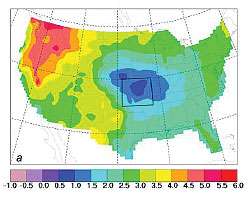Researchers Discover ‘Hole’ in Global Warming Predictions

Temperatures may not rise as high in the central United States
In the future, global warming might not be as severe in the central United States as in other parts of the country, according to scientists at Saint Louis University and Iowa State University (ISU).
Using a detailed regional climate model, these researchers estimate summertime daily maximum temperatures will not climb as high in a Midwestern region -- centered on the Missouri/Kansas border -- as anywhere else in the United States. The hole stretches for hundreds of miles and includes Missouri, Iowa, Nebraska and Oklahoma.
Image: Climate change in daily maximum temperature (K) in summer (June-July-August) simulated by RegCM2. The change is the difference between the future scenario decade (2040s) and current decade (1990s). Warming-hole averages in our analyses use the region delineated by the inner frame (35–40_N, 99–92_W). SLU/ISU graphic
The findings are published in the current issue of Geophysical Research Letters. The article’s lead author is Zaitao Pan, Ph.D., an assistant professor of earth and atmospheric sciences at Saint Louis University. The researchers say the findings underscore the need to consider the impact of global warming on a region-by-region basis.
“The modeling showed that warming in the United States will be stronger in winter than summer and stronger at night than during the day,” Pan said. “But we found what looked to us like a ‘hole’ in the daytime warming in summer, which was a surprise.”
Pan collaborated with scientists at the Regional Climate Modeling Laboratory at ISU, where he earned his Ph.D. and conducted part of this research. After discovering the ‘hole’ in climate projections for the 2040s, Pan went back to carefully examine the observed maximum daily temperatures from 1975-2000 in a region that centers in eastern Kansas and touches parts of Missouri, Oklahoma, Nebraska and Iowa.
“We found that, in fact, this hole already has started to develop,” he said.
Ray Arritt, agronomy professor at ISU, said the existence of this “hole” in the warming makes sense.
“Our model tells us the future climate will have more rainfall and wetter soil, so more of the sun’s energy goes into evaporating water than heating the air,” he said. “Rainfall in the northern Great Plains already has increased by about 10 percent over the past few decades, which is consistent with our predictions.”
Team members caution that independent evaluations are needed to confirm this finding and to determine whether the ‘hole’ might be a temporary phenomenon that will disappear as global warming becomes more severe in the latter half of the 21st century.
In addition to Pan and Arritt, co-authors are Gene Takle, Bill Gutowski, Chris Anderson and Moti Segal of ISU.
Source: Saint Louis University
















